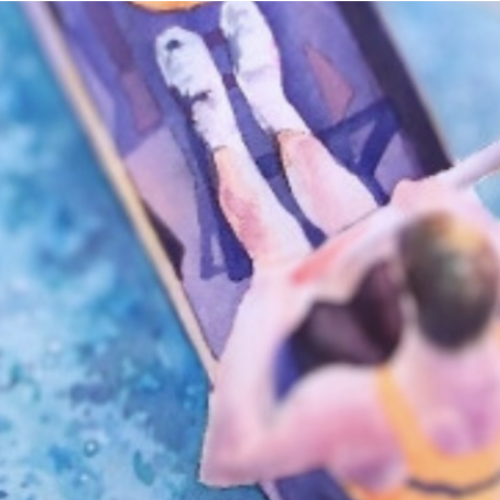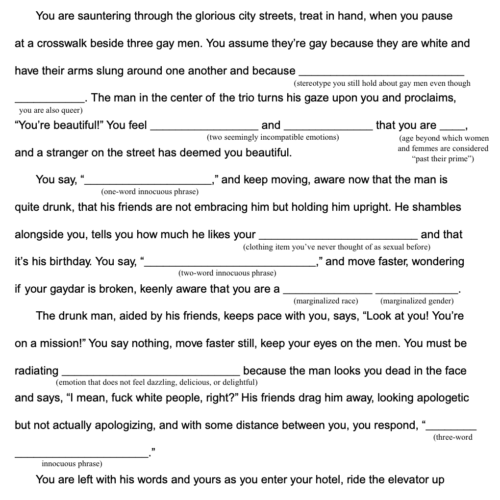“The cleverer I am at miniaturizing the world, the better I possess it.” – Gaston Bachelard, The Poetics of Space
“My map and measurements yielded a thesis which I wrote out in ink and tried to prove mathematically: the notion that affiliation is borne by proximity, and that proximity is requisite for love.” – Aislinn Hunter, The Certainties
I.
The popular tourist attraction, Madurodam, lies on the edge of Scheveningen, the seaside district of The Hague, just 5 minutes from your house in the Archipel neighborhood. Madurodam is a whimsical outdoor exhibit of miniatures representing architectural highlights from around the country. After buying tickets and having group photos taken by the hearty photographer at the entrance – kijk eens hier, look at me, smiiiile – a raised walkway along the western edge introduces visitors to a bird’s-eye view of a world of miniatures arranged in cities and landscapes somewhat divorced from their relative geography. You visit at different times, with different people, holding their arms tight and pointing to make sure they notice all there is to see. Look, Mummy, those flowers must be Keukenhof, and I bet that big building over there is the Rijksmuseum. Stepfather, do you see the canals with the locks over there? And look Daddy (visiting on a one-day stopover between New York and Nairobi) over there, the rooftops of Delft. And there, the runways of Schiphol. And, hey, older brother (the one on holiday from his New England boarding school or the other on break from his Canadian university), do you see them? The gables? The bridges? The Ferris wheel that turns in the distance?
The walkway curves inward, allowing visitors to move among the miniatures and admire the scenes and details of each knee-high building and the streetscapes with matchbox-sized vehicles and small figurines, each no more than a centimeter tall. Up close, KLM airplanes taxi on infinite mechanical loops from runway to gate; barges and pleasure crafts rise and fall on water pumped in and then released from the locks; musicians stand poised to carry their instruments into the Concert Gebouw, and; miniature rides twirl miniature people in the cheery kermis op het plein.
Despite the concrete paths and the crowds, the fantasy is almost complete. For moments at a time, you shrink down and lose yourself strolling along small squares, peering through tiny windows, entering and exiting through miniature doors. You subconsciously orient yourself to the sun’s warmth on your shoulders and the narrow shadows cast by pencil-thin lampposts. So taken in by the illusion, you barely notice the buildings are empty inside, their internal architecture purely functional. Dappled light filters through small leaves as you wonder: Do miniature people lead miniature lives? But before you find the answer, the natural elements tumble out of the strict scale as even dwarf trees grow too high, raindrops splash too hard, and monstrous sparrows topple carefully composed scenes, and there you are, tossed back onto the concrete walkway among the languages and accents of a busy tourist attraction that draws people from all parts of the world. You self-consciously cram your Instamatic back in your pocket and join the shuffle toward the exit. Before you leave, you collect the keepsake photo with your mother and stepfather, or your father, or maybe even a brother, exclaim at your crooked smiles, that stray lock of hair, or the way you squint your eyes against the light. You leave the exhibit behind, but the perspective stays with you.
II.
For birthdays and Christmases, my father sent checks, and with 10 or 25 guilders to spend, I picked out my own gifts. My mother and I walked through the centrum among rows of trees, past the rectangular pond and the fishermen, and down the pedestrian-only shopping street. Maybe we stopped at the specialty butcher for a broodje kroket, maybe she gave me a quarter for the organ grinder’s tin, but mostly I hung off her purse straps till we got to the department store. At first, tired of pawing through my brothers’ old Lego to find those matching roof pieces, I bought a set to build the perfect house with window sashes that opened and closed. But I found that while new Lego snapped together much easier than the hand-me-downs, it wasn’t as interesting to follow the plans. On a subsequent trip, I noticed the dollhouse furniture on a shelf nearby, and over the next couple of years, I lined the shelves of my new bookcase with a wooden dining table and matching chairs, armchairs upholstered in dark green velvet, a canopy bed, armoires with tiny hinges that worked, all very similar to the furniture I’d seen in the antique stores down the street and, increasingly, in our own living room, kitchen, and bedrooms.
After we moved out of the rented downtown flat to the tall row house in the Archipel, my mother surprised me with a dollhouse for my birthday. It was old, possibly antique (rickety like any old house), with a peaked roof of scalloped black cardboard. The façade swung open on weak hinges into two halves, revealing two big rooms on the ground floor and two on the top. My mother and I painted the exterior a dark, putty color with bright red trim. The interior walls were in bad shape, so we stripped the faded newspaper from one of the upstairs rooms and papered it with the pink and white Laura Ashley leftover from my own room. The rest of the house looked much like any house under renovation, with rough walls and dust-covers made from scraps of leftover fabric.
The following summer, visiting my father in New York, I showed him a catalog from a famous dollhouse store in Vermont, and, on our way to the cabin in New Brunswick, we detoured half a day out of our way to visit the store. It was filled with dolls, houses, and furniture of all colors, styles, and materials—but all I needed were a few sheets of scaled-down wallpaper with pale green stripes and little red roses. I tucked the tube of rolled-up sheets under the front seat where the dogs and cats couldn’t get it, and there it stayed all the way to the cabin and then all the way back to New York. I only fished it out in the parking lot at JFK and carried it by hand onto the plane. Later, my mother helped me paste it onto the living room walls.
*
The dollhouse was inhabited by a grey-haired lady and gent and one boy and one girl, all made of felt and yarn and dressed in old-fashioned clothing. Their clothes were too ponderous for sitting astride the pair of small horses, and, as a result, they preferred to lie rigidly in their four-poster beds. Though, with enough bending, they could be encouraged to sit on the scattered chairs and sofas or to stand about, balanced in doorways as I arranged and rearranged rugs with minuscule tassels, tin knives and forks, blue and white dishes the size of a fingernail. Rain clattered on clay roof tiles overhead. My mother rested in her room downstairs while I pasted images cut from her House & Garden magazines into cardboard frames painted with golden scrolls while the felt people lounged, sat, or stood by. Overall, they were an unusual family, or maybe quite usual, kindly enough, and if they didn’t have much to say to each other, neither did they often disagree.
*
Apart from my mother’s help, embellishing my miniature world was a solitary pursuit. Friends might have admired it from afar, or maybe they found it childish, but I alone manipulated its people and pieces; I alone moved in close to adjust a corner of the carpet or the angle of a chair, and I, alone, sat back and stared until my vision blurred and the fickle imaginary world, for one isolated moment, took on a quiet life of its own.
III.
The 10-year old lives in a four-story row house in the slowly gentrifying Archipel neighborhood of The Hague with her mother, stepfather, and a fluffy white dog called Tim, and occasional older stepbrother and brothers, whose physical presence will require the rearrangement of furniture (chairs at the dinner table, beds in bedrooms, the placement of the tv) and whose attitudes and opinions (about the city, the country, the parents) will require recalibration of her own. All this, along with an itinerant father whose appearances will throw it all out of whack, are the things over which the youngest child has much less control than she thinks yet more than she wants.
*
Her bedroom, under the eaves of the fourth floor, has a small dormer window from which she views rows of orange clay roofs and if she leans out far enough over the wide gutter, she has a dizzying perspective of the line of houses across the street vanishing north into the canal at the end of the road and south into a kaleidoscope of brick and white trim. If her room were higher, she would see the park and the empty lot she plays in each afternoon and the passageways and hidden courtyards she explores on errands for her mother. A bird soaring overhead could show her the layout of the streets she navigates each day on her way to school, hockey practice, and painting lessons.
Thankfully, she will not place a tall ladder on the steeply pitched roof, nor, alas, can she fly. She will not be shown a map of where she lives, not yet. Instead, she’ll step out her front door, maybe with a bike she has wheeled through the hallway from the tiny backyard shed, or maybe with the fluffy dog on its leash, or maybe just with a backpack and her own two feet. Her friend from across the way might be waiting, maybe with her own dogs or maybe with a few coins for candy at the tobacconist’s shop at the end of the street. Together they’ll dodge around the neighborhood, playing games that involve running and hiding, digging and building, whispers and shouts. Houses will become known by who lives there, stores by what they sell, streets by scrawls of graffiti, parks and empty lots by the secrets they hold or reveal. The more she learns about her neighborhood, the more she will understand her place in a world of constancy and change.
*
Beyond the neighborhood though, she fears getting lost: not knowing the way home, being late to school, or having to approach a stranger for help. She worries most about being missed, about causing other people concern. She will have to find her way. Her world spirals outwards slowly, then quickly: first the path along the tracks to the small pedestrian bridge across the canal, then the sidewalks and bike paths to school, then routes to whatever goes on after school: sports, lessons, that new friend with all those plastic Barbie horses with the articulated limbs. She will orient herself by the canal, the tram tracks, and an almost instinctual feeling of where the North Sea might be (west, it is west). Streets connect to other streets; wind through parks to new neighborhoods with different mixes of plants, townhouses, duplexes, and apartment buildings. She will think as she walks and watch as she bikes; miniature towns and antique dollhouses, tiny figurines, and stubborn felt dolls will give way to real-life bikes, cars, crosswalks, and people simply going about their days. She will not be able to oversee everything at once; she will direct neither traffic nor lives, but her own wrong turns will become more easily corrected, and those nagging thoughts about the people at home and the ones across the Atlantic, about where exactly they are, what they are doing, and when they might appear, those are the worries she will stave off, sun on shoulders, cobbles underfoot, replete with the details of this place and time.

Averill Groeneveld-Meijer
Averill Groeneveld-Meijer is a graduate of The Writer's Studio at Simon Fraser University. She grew up in The Hague and spent summers in New York and New Brunswick, before moving to Vancouver to study at the University of British Columbia, where she has lived ever since. She has a BA in Human Geography and an MA in Historical Geography and currently approaches time and space though creative non-fiction.




